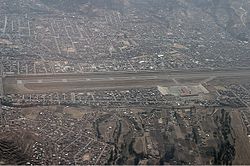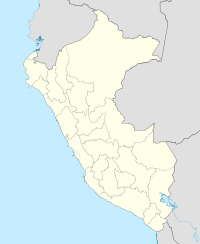Alejandro Velasco Astete International Airport
This article needs additional citations for verification. (April 2010) |
Alejandro Velasco Astete International Airport Aeropuerto Internacional Alejandro Velasco Astete | |||||||||||
|---|---|---|---|---|---|---|---|---|---|---|---|
 Aerial overview of CUZ | |||||||||||
| Summary | |||||||||||
| Airport type | Public | ||||||||||
| Operator | CORPAC S.A. | ||||||||||
| Serves | Cusco | ||||||||||
| Elevation AMSL | 10,860 ft / 3,310 m | ||||||||||
| Coordinates | 13°32′8″S 71°56′37″W / 13.53556°S 71.94361°W | ||||||||||
| Website | www.corpac.gob.pe | ||||||||||
| Runways | |||||||||||
| |||||||||||
Alejandro Velasco Astete International Airport (IATA: CUZ, ICAO: SPZO) is located in the city of Cusco, in southeastern Peru. Cusco, a principal tourist attraction in Latin America, receives various domestic flights as well as some international flights. Its runways are completely paved. Currently, it operates at limited capacity due to its precarious location near the city's center. Despite these limitations, the airport has consistently ranked as Peru's second most important air terminal, handling 1,288,200 national and international passengers in 2009, as reported by CORPAC.
Name
It was named in honor of the Peruvian pilot Alejandro Velasco Astete who was the first pilot to cross the Andes in 1925. This first flight was from Lima directly to Cusco. Later that year, in September, while trying to avoid crashing into spectators at an airshow in the city of Puno he crashed and was killed. In recognition of his pioneering achievements in Peruvian aviation history, the airport was named in his honor.
History
Previously, the airport was served by American Airlines on a JFK-LIM-CUZ-LIM-JFK routing in the late 90s (1998–1999) using Boeing 757-200 aircraft. However, these flights were discontinued due to a number of factors, including the airport's limited services and facilities as well as the Peruvian government's refusal to grant passenger transportation rights between Lima and Cuzco. American still holds the rights to this route and can resume flights at the company's discretion.
There have been a number of talks of construction of a new airport in the suburb of Chinchero, but this has created controversy as this area is home to the Pampas of Chinchero, an ecological monument.
In the past the airport received international flights from La Paz operated by Lloyd Aéreo Boliviano. However after this airline's bankruptcy in the early 2000s, the route has been taken over by Aerosur, which also serves Santa Cruz de la Sierra's Viru Viru International Airport. The airport also received flights from the city of Arica in Chile operated by the defunct Chilean airline Ladeco.
Design
The airport has a number of commodities which attend to the multitude of tourists which visit the city of Cusco. A number of years ago, it was the first Peruvian airport to make use of jetways. The runway is paved and is 3400 meters (11,155 feet) long and 45 meters (148 feet) wide.
Airlines and destinations
| Airlines | Destinations |
|---|---|
| Aerosur | La Paz, Santa Cruz de la Sierra |
| LAN Perú | Arequipa, Juliaca, Lima, Puerto Maldonado |
| Peruvian Airlines | Lima |
| Star Perú | Arequipa, Juliaca, Lima, Puerto Maldonado |
| TACA Perú | Lima |
Accident
On August 9, 1970, LANSA Flight 502, a four-engine engine Lockheed L-188A Electra turboprop, crashed shortly after takeoff from the Cusco airport, killing 99 of the 100 people on board, plus two people on the ground, in the deadliest accident in Peru's aviation history to that date. 49 of the passengers were high school exchange students visiting Peru from Buffalo, New York. Investigation revealed the accident was caused by improper piloting technique and poor maintenance. The airline was suspended and fined by the Peruvian government. A memorial — a large white cross with a nameplate — has been erected for the victims near the crash site, about a mile and a half west-north-west from the airport.[1][2][3]
References
- ^ "Accident record". Aviation Safety Network. Retrieved 2009-06-18.
- ^ "Peruvian Line Suspended". New York Times. September 3, 1970. p. 32.
- ^ "Schumer Announces Peruvian Memorial For Plane Crash Victims Will Be Moved To Safe Location". U.S. Senate (Schumer press release). Retrieved 2009-06-17.

